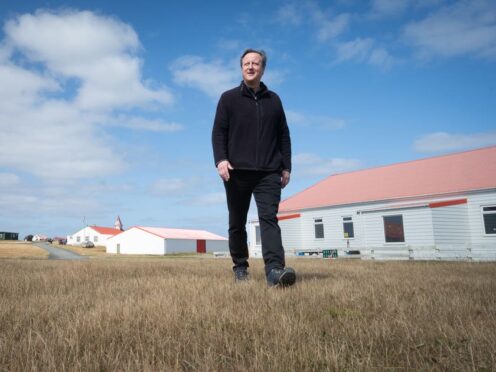
Lord David Cameron toured Falklands War battle sites as he became the first Foreign Secretary to visit the South Atlantic territory in 30 years.
His visit was a high-profile demonstration that the islands are “part of the British family” amid fresh calls from Argentina for talks about their future.
The former prime minister was taken on a helicopter tour of the islands, stopping at San Carlos and Goose Green – two of the most significant sites in the 1982 war.

San Carlos Water became nicknamed “bomb alley” due to the sustained aerial attacks faced by British warships during the operation to land troops on the islands.
Three Royal Navy ships were lost during the Battle of San Carlos in May 1982.
Lord Cameron inspected the graves in the cemetery, including that of Lt Col H Jones, commander of 2 Para who won a posthumous Victoria Cross during the war, before laying a wreath at the monument to those who died.
Lt Col Jones was killed at the Battle of Goose Green and Lord Cameron also visited the settlement there as part of his tour.
He visited the museum and spoke to local residents at the community hall.
During the war, islanders were detained in the building until the Argentine forces surrendered.
The battle came at a heavy cost, with 18 British soldiers killed including Lt Col H Jones.
Writing in the community hall visitors’ book, Lord Cameron said: “Thank you for keeping their memory alive.”
He also paid tribute to the dead on the other side in the conflict with a low-key visit to the Argentine military cemetery.

Argentina’s president, Javier Milei – who met Lord Cameron last month, has called for the South Atlantic islands to be handed over to Buenos Aires.
But ahead of his arrival in the UK overseas territory, Lord Cameron said: “The Falkland Islands are a valued part of the British family, and we are clear that as long as they want to remain part of the family, the issue of sovereignty will not be up for discussion.”
The shadow of the 1982 Falklands War hangs over UK-Argentine relations, but Lord Cameron and Mr Milei had a “warm and cordial” meeting at the World Economic Forum in Davos.
On the issue of the Falklands, the Foreign Office said “they would agree to disagree, and do so politely”.
The former prime minister’s visit is the first by a member of the Cabinet since then-defence secretary Sir Michael Fallon’s trip in 2016.
The last visit by a foreign secretary was Lord Hurd in 1994.
The Falklands, known as Islas Malvinas in Argentina, are about 8,000 miles from Britain and 300 miles from mainland Argentina.
The 1982 conflict claimed the lives of 255 British servicemen, three islanders and 649 Argentinian personnel.
In a 2013 referendum, the islanders voted overwhelmingly to retain their status as a UK overseas territory.
But Mr Milei has suggested the UK should approach the issue in a way similar to the handover of Hong Kong to China in 1997.

Enjoy the convenience of having The Sunday Post delivered as a digital ePaper straight to your smartphone, tablet or computer.
Subscribe for only £5.49 a month and enjoy all the benefits of the printed paper as a digital replica.
Subscribe